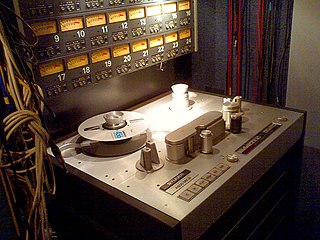Linear Timecode (LTC) is an encoding of SMPTE timecode data in an audio signal, as defined in SMPTE 12M specification. The audio signal is commonly recorded on a VTR track or other storage media. The bits are encoded using the biphase mark code : a 0 bit has a single transition at the start of the bit period. A 1 bit has two transitions, at the beginning and middle of the period. This encoding is self-clocking. Each frame is terminated by a 'sync word' which has a special predefined sync relationship with any video or film content.

NTSC, named after the National Television System Committee, is the analog television color system that was used in North America from 1954 and until digital conversion, was used in most of the Americas ; Myanmar; South Korea; Taiwan; Philippines; Japan; and some Pacific island nations and territories.

35 mm film (millimeter) is the film gauge most commonly used for motion pictures and chemical still photography. The name of the gauge refers to the width of the photographic film, which consists of strips 34.98 ±0.03 mm (1.377 ±0.001 inches) wide. The standard negative pulldown for movies is four perforations per frame along both edges, which results in 16 frames per foot of film. For still photography, the standard frame has eight perforations on each side.
A timecode is a sequence of numeric codes generated at regular intervals by a timing synchronization system. Timecode is used in video production, show control and other application which require temporal coordination or logging of recording or actions.
Material Exchange Format (MXF) is a container format for professional digital video and audio media defined by a set of SMPTE standards. A typical example of its use is for delivering advertisements to TV stations.
SMPTE timecode is a set of cooperating standards to label individual frames of video or film with a timecode. The system is defined by the Society of Motion Picture and Television Engineers in the SMPTE 12M specification. SMPTE revised the standard in 2008, turning it into a two-part document: SMPTE 12M-1 and SMPTE 12M-2, including new explanations and clarifications.

Nagra is a brand of portable audio recorders produced from 1951 in Switzerland. Since 1997 a range of high-end equipment aimed at the audiophile community was introduced as a diversification into a hitherto unknown market.

Dolby Laboratories, Inc. is an American company specializing in audio noise reduction and audio encoding/compression. Dolby licenses its technologies to consumer electronics manufacturers.

5.1 surround sound is the common name for six channel surround sound audio systems. 5.1 is the most commonly used layout in home theatre. It uses five full bandwidth channels and one low-frequency effects channel. Dolby Digital, Dolby Pro Logic II, DTS, SDDS, and THX are all common 5.1 systems. 5.1 is also the standard surround sound audio component of digital broadcast and music.

Sound-on-film is a class of sound film processes where the sound accompanying a picture is physically recorded onto photographic film, usually, but not always, the same strip of film carrying the picture. Sound-on-film processes can either record an analog sound track or digital sound track, and may record the signal either optically or magnetically. Earlier technologies were sound-on-disc, meaning the film's soundtrack would be on a separate phonograph record.
The Cineon System was one of the first computer based digital film system created by Kodak in the early 1990s. It was an integrated suite of components consisting a Motion picture film scanner, a film recorder and workstation hardware with software for compositing, visual effects, image restoration and color management.
Dolby Stereo is a trademark of Dolby Laboratories, for its various stereo sound formats.

1 inch type B VTR is a reel-to-reel analog recording video tape format developed by the Bosch Fernseh division of Bosch in Germany in 1976. The magnetic tape format became the broadcasting standard in continental Europe, but adoption was limited in the United States and United Kingdom, where the Type C videotape VTR was met with greater success.
Cinema Digital Sound (CDS) was a multi-channel surround sound format used for theatrical films in the early 1990s. The system was developed by Eastman Kodak and Optical Radiation Corporation. CDS was quickly superseded by Digital Theatre System (DTS) and Dolby Digital formats.
Control track longitudinal, or CTL, timecode, developed by JVC in the early 1990s, is a unique technique for embedding, or striping, reference SMPTE timecode onto a videotape.

D6 HDTV VTR is SMPTE videocassette standard. A D6 VTR can record and playback HDTV video uncompressed. The only D6 VTR product is the Philips, now Thomson's Grass Valley's Media Recorder, model DCR 6024, also called the D6 Voodoo VTR. The VTR was a joint project between Philips Digital Video Systems of Germany and Toshiba in Japan. The tape deck module was designed and made by Philips in Weiterstadt, Germany, and the digital processor module designed and made by Toshiba. Since there is no data compression, after 20 tape copies of multi generations there is no noticeable loss of quality. As a very high-end, costly system about 70 were sold to high-end post houses from about 2000 to 2005. The VTR had a data record option. The data module could record and play back 2k DPX files at 6 frames per second over a HIPPI connection. The VTR came in a data only model, or with a switch module, so the record deck could be used for both video and data recording. The tape deck was also sold stand alone as a giga bit recorder to record and playback raw data. Toshiba made the video tape for the VTR. The high price of the video tape limited the use of the VTR.
LC Concept was a 35 mm film projection sound format, developed in France and released in 1991. It used 5.25" 300 megabyte capacity re-writable magneto-optical disks to hold 4 or 5.1 channels of MUSICAM compressed audio. Two disks were used to hold approximately three hours of sound. The system was adopted in France, Belgium, and Switzerland. A large litigation against Universal, Spielberg and DTS frightened the investors. DTS had to buy the LC patents to resolve the issue.
General eXchange Format (GXF), is a file exchange format for the transfer of simple and compound clips between television program storage systems. It is a container format that can contain Motion JPEG (M-JPEG), MPEG, or DV-based video compression standards, with associated audio, time code, and user data that may include user-defined metadata.
A Digital Cinema Package (DCP) is a collection of digital files used to store and convey digital cinema (DC) audio, image, and data streams.









